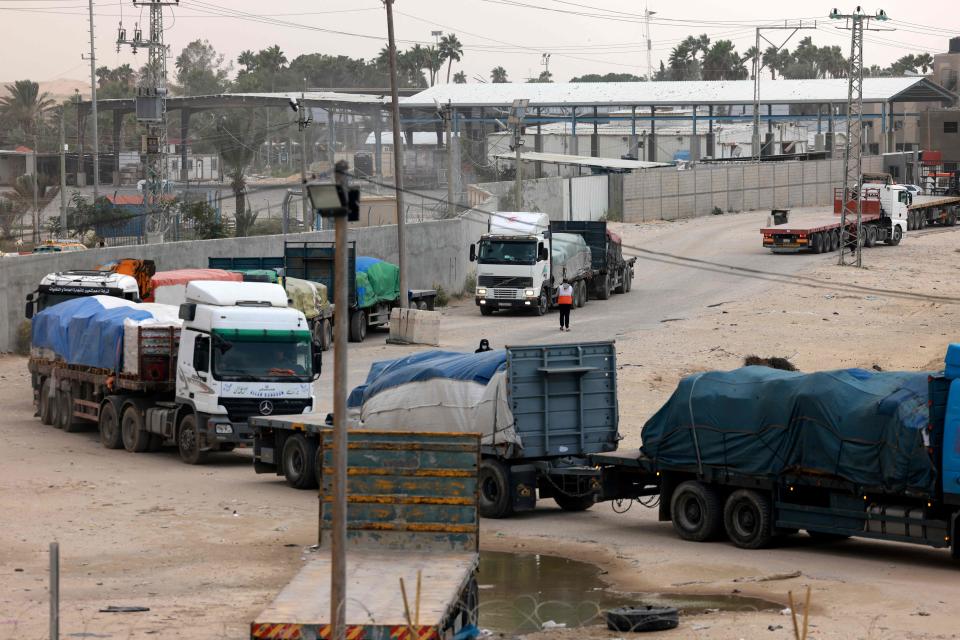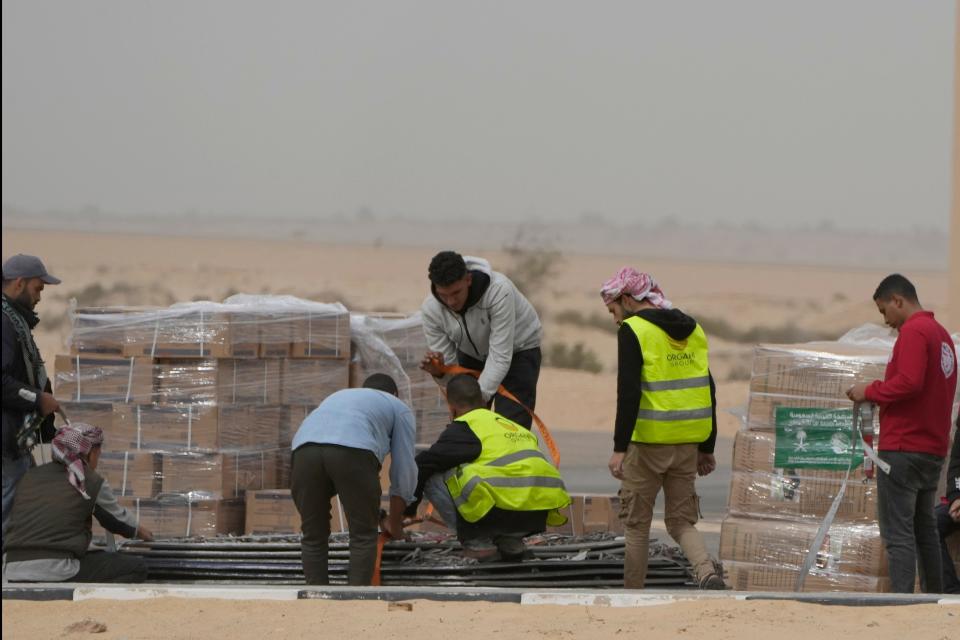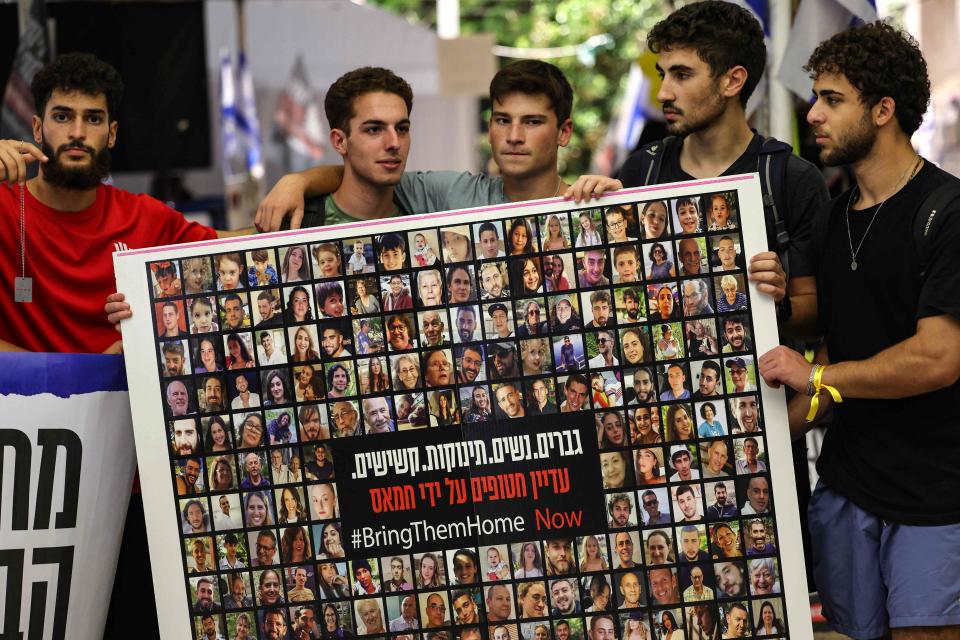Biden is sending $100M in aid into Gaza. Is any of it ending up in the hands of Hamas?
- Oops!Something went wrong.Please try again later.
WASHINGTON – For five weeks, delivery trucks crossing into the Gaza Strip from Egypt have carried food, water and other supplies to Palestinians facing life-threatening shortages of basic supplies.
The Biden administration, which helped broker the deal allowing the deliveries, has pledged $100 million in humanitarian assistance to the Palestinians amid the crisis triggered by the Israel-Hamas war. More could be released in response to a hostage-release deal announced last week.
But the administration’s desire to send much-needed aid has run up against fears that some aid could end up in the hands of Hamas, the militant group that governs Gaza and whose surprise deadly attack on Israel on Oct. 7 touched off the latest conflict. The U.S. has designated Hamas a terrorist organization.
“Why would we spend a minute of our time … to figure out how to get more aid to Gaza to help terrorists? This makes no sense,” Sen. Rick Scott, R-Fla., said just hours after President Joe Biden announced the assistance.
U.S. officials have been keenly aware for decades of aid money such as domestic welfare payments to Palestinian families and individuals being used to support terrorism. The Israeli government also has accused Hamas of directing millions of dollars intended for projects such as roads, bridges or hospitals to be used instead to build a network of underground tunnels that serve as a transportation route for terrorists and weapons.
The Biden administration acknowledged there are legitimate concerns that Hamas might divert or steal some of the aid, and Biden warned that the assistance will stop if that happens.
The U.S. wants to make sure it is helping the Palestinians, not Hamas. But distinguishing between the two can be challenging because Hamas comprises a military wing and a governing authority that is in charge of everything in Gaza, from the health ministry to road construction.
The U.S. has seen no indication that Hamas has gotten its hands on any of the latest assistance that has entered Gaza, said John Kirby, the White House spokesman for national security matters.
As of last week, more than 1,370 truckloads of humanitarian assistance had entered Gaza after 50 arrived during a 24-hour span, Kirby said. The pace is far short of the goal of 150 trucks a day. The food, water and other aid goes from United Nations trucks to humanitarian organizations that then deliver it to the people of Gaza.
Inspections and other mitigation measures are in place to keep the aid from being stolen and to make sure it gets to people who need it most, the administration says.
With nearly 1.7 million of Gaza’s 2.3 million people displaced by the war, “the need is close to catastrophic at this stage,” said Hardin Lang, of Refugees International, a nonprofit group based in Washington.
Homes and businesses have been destroyed, the Hamas government bureaucracy is not functioning, hospitals are being used by militants, and there are severe shortages of water, food and fuel, said Matthew Levitt, a senior fellow with the Washington Institute for Near East Policy, a think tank based in Washington.
“Given the nature of this crisis and the fact that there is the ability to alleviate some of the humanitarian crisis, we should do that,” Levitt said.
Humanitarian assistance has never been conditioned on the guarantee that every penny must be stopped from going to militants or there would be no aid, Levitt said.
“There's got to be a balance between the two,” he said. “At the end of the day, what we're about is preventing people from dying.”
Hostage deal: Inside the 'excruciating' work of a secret US cell that secured the release of 50 hostages

'High-risk for potential diversion and misuse'
U.S. aid to Palestinians usually flows through contributions to the United Nations Relief and Works Agency for Palestine Refugees in the Near East, or UNRWA. The agency, created in 1949, provides education, health care and other social services to more than 5 million registered Palestinian refugees in the West Bank, Gaza, Lebanon, Jordan and Syria.
Other aid, including emergency food, water and medicine, can flow through various other aid programs, including emergency appropriations by Congress.
Of the $100 million in humanitarian assistance recently announced, $34 million is going through the U.S. Agency for International Development, which is primarily responsible for administering civilian foreign aid and development assistance.
In response to mounting health needs, the agency and its partners have provided pharmaceuticals and other medical supplies to Palestinians, including civilians at Gaza’s Al Ahli Hospital after a deadly explosion on Oct. 17, a spokesperson for USAID said.
Almost 1,000 people in southern Gaza have been given psychological first aid while hundreds of others in shelters and health facilities have received mental health counseling. The U.N. World Food Programme has distributed electronic food vouchers to 522,000 civilians in Gaza. A nongovernmental organization working with USAID is distributing 3,000 hygiene kits to displaced woman at shelters and through community-based organizations in Gaza.
The aid also includes food, health care, medicine, nutrition, shelter, and water and sanitation services. None of it is used for infrastructure repairs, the spokesperson said.
USAID would not name the nongovernmental organizations it is working with to deliver the supplies, citing security concerns. But the spokesperson said several precautions have been taken to ensure that none of the assistance ends up in the hands of Hamas.
Partner organizations are carefully vetted and must certify that they will comply with anti-terrorism laws. Grants and contracts include anti-terrorism provisions. And officials are working closely with the Israelis, who are reportedly inspecting the deliveries to make sure no weapons are smuggled into the area.
U.S. aid for Palestinians also remains subject to numerous conditions in annual congressional appropriations legislation and elsewhere. The conditions are designed, in part, to prevent Palestinian leaders from using such domestic welfare payments “for acts of terrorism,” according to a report by the Congressional Research Service, the independent research arm of Congress.
The report didn’t single out Hamas for siphoning off any money for terrorism. But Hamas, as a political organization, controls Gaza. So concerns persist that Hamas could end up with at least some of the $100 million in assistance flowing into Gaza.
A report by USAID’s Office of Inspector General after Biden announced the package identified it as “high-risk for potential diversion and misuse.”
Two Republican senators – Tim Scott of South Carolina and Pete Ricketts of Nevada – are pushing legislation to keep foreign aid from benefiting Hamas or other terrorist groups.
Rep. Michael McCaul, R-Texas, chairman of the House Foreign Affairs Committee, said Egypt and Israel are monitoring the supplies entering Gaza and are searching the delivery trucks to make sure nothing gets in that could benefit Hamas.
“That gives me some confidence – that Israel ... they're the ones screening the trucks going in,” he said.
In terms of people leaving Gaza, “the last thing the Egyptians want would be Hamas coming into their country because they've had to deal with the Muslim Brotherhood for quite some time, and nobody wants to stop Hamas from coming into Egypt more than the Egyptians,” he said. “And they know how to screen pretty well."
An American who runs a large aid group that has for years worked on infrastructure projects in Gaza said his organization follows a "no contact" policy when it comes to dealing with Hamas.
"They don't ask us for anything. We don't ask them for anything," said the aid worker, who did not want to be publicly identified because of his organization's work in Gaza, which has temporarily shifted from public-utilities-related work to sourcing and delivering meals.
The U.S. has targeted individual Hamas leaders with travel bans, asset freezes and arms embargoes. It does not maintain so-called jurisdiction-based sanctions on Gaza and the West Bank, a separate Palestinian territory.
That means that while the U.S. Treasury Department urges humanitarian groups and U.S. companies to make sure food, agricultural commodities, medicine, medical devices and components for development projects don't end up in the hands of "blocked" individuals or their "fraudulent charities," it does not prohibit aid groups from supplying these goods and services to the Hamas-run strip.
"That doesn't mean you can't ever talk with anyone from Hamas, because if we're doing a water network then we have to speak with some people from, for example, the Coastal Management Water unit in Gaza," the American aid worker said. "And some of those guys are Hamas. We can't talk to the higher-up levels. But there is coordination on a technical level. There just can't be anything political."
The presence of Hamas “never really seemed to affect our work,” he said.
The aid worker mentioned a few examples related to him by his staff in Gaza when there was some minor interference. One time, he said, Hamas operatives showed up to a site where his group was working and demanded some old water pipes. The group refused.
Another time, his organization was building a school with U.S. funding in a building that used to house a U.N.-built school. One day, a Hamas official showed up and halted the project because of a land dispute, he said. He said his organization also has had disputes with Israel, in the West Bank, when it has tried to build schools for Palestinians on Palestinian land.
Hurling insults, Molotov cocktails: Jews live in fear as antisemitism rages

'A fraction of what's needed'
Hamas is far less capable of scamming or stealing humanitarian aid than it was before the start of the war, Levitt said. Hamas officials controlled the police force and the crossings into Gaza before the Oct. 7 attack. Now, “they’re hiding in tunnels and on the run,” Levitt said.
Another factor to consider: The amount of humanitarian aid going into Gaza “is so paltry … that the issue of diversion really doesn’t seem to be in play,” Lang said. “The amount of assistance that’s getting into Gaza is a fraction of what’s needed.”
More could start flowing into Gaza soon, however.
In Washington, at least 13 Democratic senators have written to Biden urging him to put pressure on Israel to take immediate steps, including reopening a major border crossing, so humanitarian aid can flow to civilians in Gaza.
The letter, dated Nov. 20, stressed the humanitarian crisis and the need for water, food, fuel and medicine.
State Department spokesman Matthew Miller said last week that the hostage-release deal could mean additional humanitarian assistance to the Palestinians.
Miller said that while the U.S. has always maintained that a hostage deal is not needed to release more humanitarian aid, “it has been clear that for some time that an agreement on hostages would release or would unlock the potential for delivery of more humanitarian assistance.”
Hostage deal: How tiny Qatar became the middle man in negotiations to free hostages held by Hamas
As aid has trickled into Gaza on trucks, Cyprus has offered to open a maritime corridor. Cyprus President Nikos Christodoulides said the proposal would be a feasible way to significantly supplement the aid going into Gaza through Egypt’s Rafah border checkpoint.
Cyprus is only about 210 nautical miles from Gaza, but it's not clear how practical it would be to safely land cargo in Gaza's tiny port facilities. And Gaza's only major seaport, according to The Maritime Executive, an industry website for maritime news, is at the north end of the territory in Gaza City, the de facto epicenter of Israel's military operation.
Contributing: Joey Garrison and Francesca Chambers
'Self-silencing': For Palestinians, talking about Hamas comes with hazards

This article originally appeared on USA TODAY: Biden sending aid into Gaza. Is any of it ending up in hands of Hamas?

